Giuseppe Marra
Department of Computer Science, KU Leuven
DeepGraphLog for Layered Neurosymbolic AI
Sep 09, 2025Abstract:Neurosymbolic AI (NeSy) aims to integrate the statistical strengths of neural networks with the interpretability and structure of symbolic reasoning. However, current NeSy frameworks like DeepProbLog enforce a fixed flow where symbolic reasoning always follows neural processing. This restricts their ability to model complex dependencies, especially in irregular data structures such as graphs. In this work, we introduce DeepGraphLog, a novel NeSy framework that extends ProbLog with Graph Neural Predicates. DeepGraphLog enables multi-layer neural-symbolic reasoning, allowing neural and symbolic components to be layered in arbitrary order. In contrast to DeepProbLog, which cannot handle symbolic reasoning via neural methods, DeepGraphLog treats symbolic representations as graphs, enabling them to be processed by Graph Neural Networks (GNNs). We showcase the capabilities of DeepGraphLog on tasks in planning, knowledge graph completion with distant supervision, and GNN expressivity. Our results demonstrate that DeepGraphLog effectively captures complex relational dependencies, overcoming key limitations of existing NeSy systems. By broadening the applicability of neurosymbolic AI to graph-structured domains, DeepGraphLog offers a more expressive and flexible framework for neural-symbolic integration.
Valid Text-to-SQL Generation with Unification-based DeepStochLog
Mar 17, 2025Abstract:Large language models have been used to translate natural language questions to SQL queries. Without hard constraints on syntax and database schema, they occasionally produce invalid queries that are not executable. These failures limit the usage of these systems in real-life scenarios. We propose a neurosymbolic framework that imposes SQL syntax and schema constraints with unification-based definite clause grammars and thus guarantees the generation of valid queries. Our framework also builds a bi-directional interface to language models to leverage their natural language understanding abilities. The evaluation results on a subset of SQL grammars show that all our output queries are valid. This work is the first step towards extending language models with unification-based grammars. We demonstrate this extension enhances the validity, execution accuracy, and ground truth alignment of the underlying language model by a large margin. Our code is available at https://github.com/ML-KULeuven/deepstochlog-lm.
Neural Interpretable Reasoning
Feb 17, 2025

Abstract:We formalize a novel modeling framework for achieving interpretability in deep learning, anchored in the principle of inference equivariance. While the direct verification of interpretability scales exponentially with the number of variables of the system, we show that this complexity can be mitigated by treating interpretability as a Markovian property and employing neural re-parametrization techniques. Building on these insights, we propose a new modeling paradigm -- neural generation and interpretable execution -- that enables scalable verification of equivariance. This paradigm provides a general approach for designing Neural Interpretable Reasoners that are not only expressive but also transparent.
Relational Neurosymbolic Markov Models
Dec 17, 2024



Abstract:Sequential problems are ubiquitous in AI, such as in reinforcement learning or natural language processing. State-of-the-art deep sequential models, like transformers, excel in these settings but fail to guarantee the satisfaction of constraints necessary for trustworthy deployment. In contrast, neurosymbolic AI (NeSy) provides a sound formalism to enforce constraints in deep probabilistic models but scales exponentially on sequential problems. To overcome these limitations, we introduce relational neurosymbolic Markov models (NeSy-MMs), a new class of end-to-end differentiable sequential models that integrate and provably satisfy relational logical constraints. We propose a strategy for inference and learning that scales on sequential settings, and that combines approximate Bayesian inference, automated reasoning, and gradient estimation. Our experiments show that NeSy-MMs can solve problems beyond the current state-of-the-art in neurosymbolic AI and still provide strong guarantees with respect to desired properties. Moreover, we show that our models are more interpretable and that constraints can be adapted at test time to out-of-distribution scenarios.
Aligning Generalisation Between Humans and Machines
Nov 23, 2024



Abstract:Recent advances in AI -- including generative approaches -- have resulted in technology that can support humans in scientific discovery and decision support but may also disrupt democracies and target individuals. The responsible use of AI increasingly shows the need for human-AI teaming, necessitating effective interaction between humans and machines. A crucial yet often overlooked aspect of these interactions is the different ways in which humans and machines generalise. In cognitive science, human generalisation commonly involves abstraction and concept learning. In contrast, AI generalisation encompasses out-of-domain generalisation in machine learning, rule-based reasoning in symbolic AI, and abstraction in neuro-symbolic AI. In this perspective paper, we combine insights from AI and cognitive science to identify key commonalities and differences across three dimensions: notions of generalisation, methods for generalisation, and evaluation of generalisation. We map the different conceptualisations of generalisation in AI and cognitive science along these three dimensions and consider their role in human-AI teaming. This results in interdisciplinary challenges across AI and cognitive science that must be tackled to provide a foundation for effective and cognitively supported alignment in human-AI teaming scenarios.
Interpretable Concept-Based Memory Reasoning
Jul 22, 2024



Abstract:The lack of transparency in the decision-making processes of deep learning systems presents a significant challenge in modern artificial intelligence (AI), as it impairs users' ability to rely on and verify these systems. To address this challenge, Concept Bottleneck Models (CBMs) have made significant progress by incorporating human-interpretable concepts into deep learning architectures. This approach allows predictions to be traced back to specific concept patterns that users can understand and potentially intervene on. However, existing CBMs' task predictors are not fully interpretable, preventing a thorough analysis and any form of formal verification of their decision-making process prior to deployment, thereby raising significant reliability concerns. To bridge this gap, we introduce Concept-based Memory Reasoner (CMR), a novel CBM designed to provide a human-understandable and provably-verifiable task prediction process. Our approach is to model each task prediction as a neural selection mechanism over a memory of learnable logic rules, followed by a symbolic evaluation of the selected rule. The presence of an explicit memory and the symbolic evaluation allow domain experts to inspect and formally verify the validity of certain global properties of interest for the task prediction process. Experimental results demonstrate that CMR achieves comparable accuracy-interpretability trade-offs to state-of-the-art CBMs, discovers logic rules consistent with ground truths, allows for rule interventions, and allows pre-deployment verification.
Causal Concept Embedding Models: Beyond Causal Opacity in Deep Learning
May 28, 2024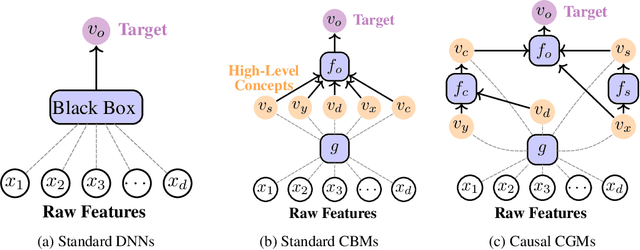



Abstract:Causal opacity denotes the difficulty in understanding the "hidden" causal structure underlying a deep neural network's (DNN) reasoning. This leads to the inability to rely on and verify state-of-the-art DNN-based systems especially in high-stakes scenarios. For this reason, causal opacity represents a key open challenge at the intersection of deep learning, interpretability, and causality. This work addresses this gap by introducing Causal Concept Embedding Models (Causal CEMs), a class of interpretable models whose decision-making process is causally transparent by design. The results of our experiments show that Causal CEMs can: (i) match the generalization performance of causally-opaque models, (ii) support the analysis of interventional and counterfactual scenarios, thereby improving the model's causal interpretability and supporting the effective verification of its reliability and fairness, and (iii) enable human-in-the-loop corrections to mispredicted intermediate reasoning steps, boosting not just downstream accuracy after corrections but also accuracy of the explanation provided for a specific instance.
Towards a fully declarative neuro-symbolic language
May 15, 2024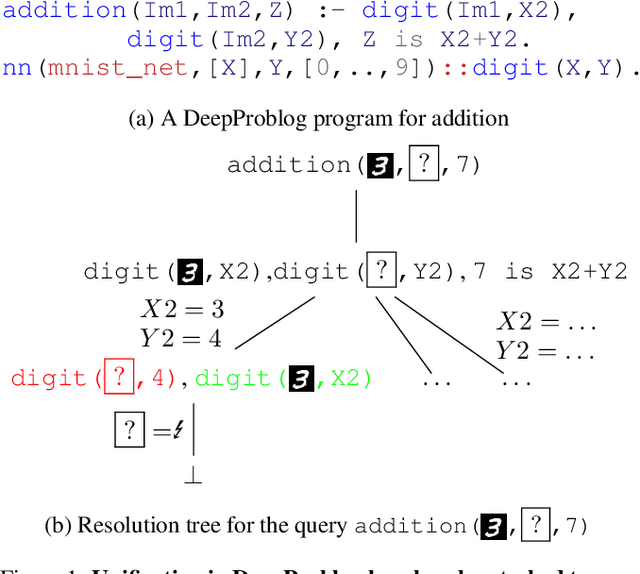
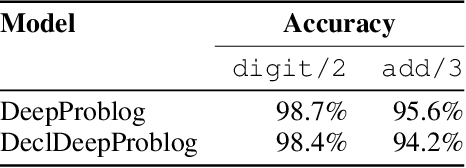

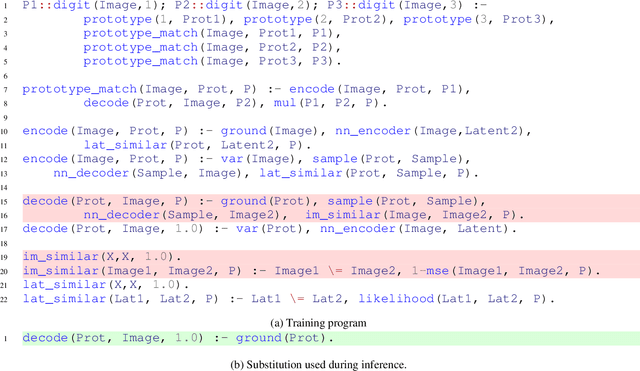
Abstract:Neuro-symbolic systems (NeSy), which claim to combine the best of both learning and reasoning capabilities of artificial intelligence, are missing a core property of reasoning systems: Declarativeness. The lack of declarativeness is caused by the functional nature of neural predicates inherited from neural networks. We propose and implement a general framework for fully declarative neural predicates, which hence extends to fully declarative NeSy frameworks. We first show that the declarative extension preserves the learning and reasoning capabilities while being able to answer arbitrary queries while only being trained on a single query type.
Climbing the Ladder of Interpretability with Counterfactual Concept Bottleneck Models
Feb 02, 2024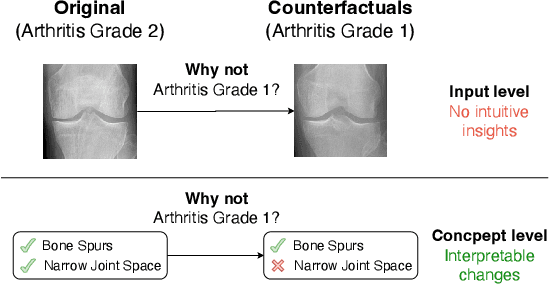
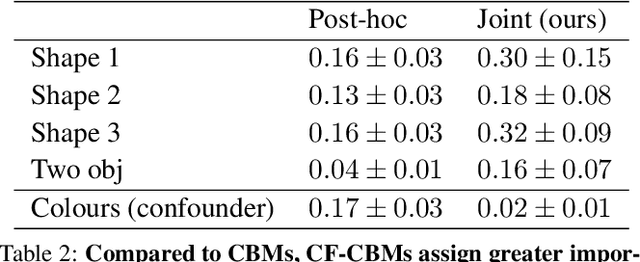


Abstract:Current deep learning models are not designed to simultaneously address three fundamental questions: predict class labels to solve a given classification task (the "What?"), explain task predictions (the "Why?"), and imagine alternative scenarios that could result in different predictions (the "What if?"). The inability to answer these questions represents a crucial gap in deploying reliable AI agents, calibrating human trust, and deepening human-machine interaction. To bridge this gap, we introduce CounterFactual Concept Bottleneck Models (CF-CBMs), a class of models designed to efficiently address the above queries all at once without the need to run post-hoc searches. Our results show that CF-CBMs produce: accurate predictions (the "What?"), simple explanations for task predictions (the "Why?"), and interpretable counterfactuals (the "What if?"). CF-CBMs can also sample or estimate the most probable counterfactual to: (i) explain the effect of concept interventions on tasks, (ii) show users how to get a desired class label, and (iii) propose concept interventions via "task-driven" interventions.
Relational Concept Based Models
Aug 23, 2023



Abstract:The design of interpretable deep learning models working in relational domains poses an open challenge: interpretable deep learning methods, such as Concept-Based Models (CBMs), are not designed to solve relational problems, while relational models are not as interpretable as CBMs. To address this problem, we propose Relational Concept-Based Models, a family of relational deep learning methods providing interpretable task predictions. Our experiments, ranging from image classification to link prediction in knowledge graphs, show that relational CBMs (i) match generalization performance of existing relational black-boxes (as opposed to non-relational CBMs), (ii) support the generation of quantified concept-based explanations, (iii) effectively respond to test-time interventions, and (iv) withstand demanding settings including out-of-distribution scenarios, limited training data regimes, and scarce concept supervisions.
 Add to Chrome
Add to Chrome Add to Firefox
Add to Firefox Add to Edge
Add to Edge